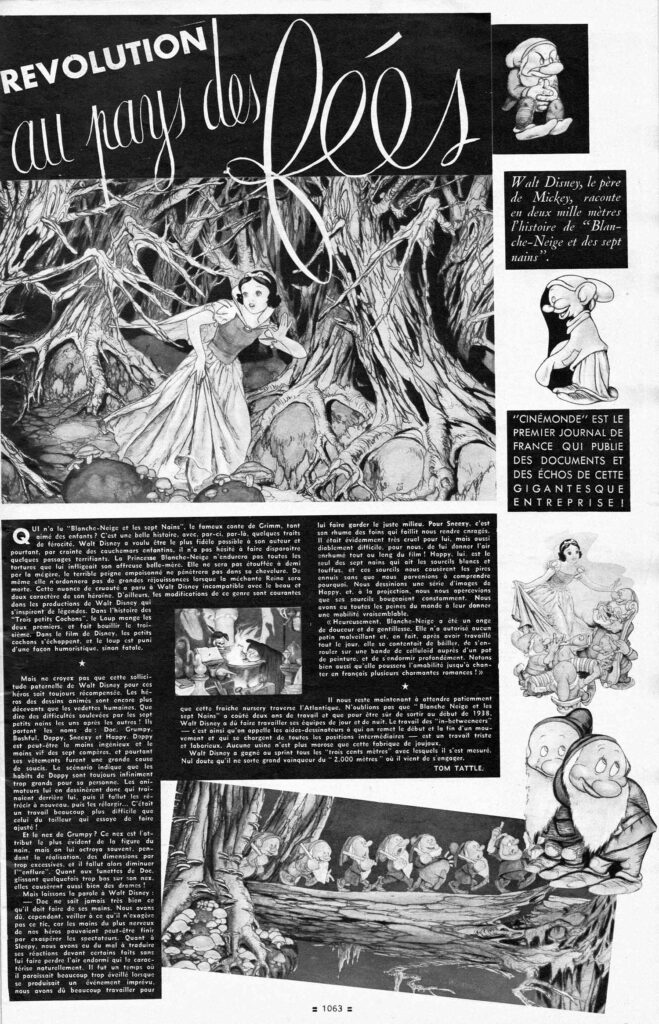Cinémonde is a film magazine published between November 1928 until 1968 with an interruption during World War II. At the time of the release of Snow White and the Seven Dwarfs, Maurice Bessy has been running the magazine since 1934.

December 1937
The Christmas edition of Cinémonde was published yearly in December. It had many more pages than the rest of the year and was partly in color. In the 1937 edition, Tom Tattle (a pseudonym for Maurice Bessy?) wrote an article in which he presents the film and supposedly reproduces a Walt Disney text. In it, the dwarfs are still called by their English names since the film remains to be translated, but Dopey’s name is somehow misspelt “Doppy”. Here is the text:
Revolution in Fairyland
by Tom Tattle aka Maurice Bessy (December 1937)
Walt Disney, Mickey’s father, tells the story of “Snow White and the Seven Dwarfs” in two thousand meters.
“Cinémonde” was the first newspaper in France to publish documents and echoes of this gigantic undertaking!
Who hasn’t read “Snow White and the Seven Dwarfs”, the famous Grimm fairy tale so beloved by children? It’s a beautiful story, with a touch of ferocity here and there. Walt Disney wanted to be as faithful as possible to his author, yet for fear of children’s nightmares, he didn’t hesitate to remove a few terrifying passages. Princess Snow White will not endure all the torture inflicted on her by her dreadful stepmother. She won’t be choked half to death by the vixen, and the terrible poison comb won’t penetrate her hair. Nor will she order great rejoicings when the wicked Queen is dead. Walt Disney felt that this nuance of cruelty was incompatible with the beautiful, gentle character of his heroine. Changes of this kind are common in Walt Disney productions based on legends. In the story of the “Three Little Pigs”, the Wolf eats the first two, and boils the third. In the Disney film, the little pigs escape, and the Wolf is punished in a humorous, if not fatal, way.
But don’t think that Walt Disney’s paternal concern for these heroes is always rewarded. Cartoon heroes are even more disappointing than human stars. What can we say about the difficulties raised by the seven little dwarfs one after the other! Their names are Doc, Grumpy, Bashful, Doppy, Sneezy and Happy. Doppy is perhaps the least ingenious and visually impaired of the seven, yet his clothes were a great cause for concern. The script states that Doppy’s clothes are always infinitely too big for him. So the animators drew him some that were trailing behind him, then they had to shrink them again, then widen them… It was a much harder job than the tailor trying to fit!
And Grumpy’s nose? The nose is the most obvious feature of the dwarf’s figure, but it was often over-dimensioned during production, and the “swelling” had to be reduced. As for Doc’s glasses, which sometimes slipped too low down his nose, they also caused a lot of drama.
But let’s hear it from Walt Disney:
Doc never quite knows what to do with his hands. We did, however, have to make sure that he didn’t overdo it, as the hands of the most nervous of our heroes could perhaps end up exasperating the audience. As for Sleepy, we had a hard time translating his reactions to certain facts without making him lose his naturally sleepy air. There was a time when he seemed far too awake when something unexpected happened, and we had to work hard to get him to strike the right balance. As for Sneezy, it was his hay fever that nearly drove us mad. It was obviously very cruel for him, but also devilishly difficult for us to make him look like he had a cold throughout the film! Happy is the only one of the seven dwarfs to have bushy white eyebrows, and those eyebrows caused us the most trouble, and we couldn’t figure out why. We drew a series of images of Happy, and when we projected them, we noticed that his eyebrows were constantly moving. We had the hardest time in the world getting them to move in a believable way.
“Fortunately, Snow White was an angel of gentleness and kindness. She allowed no malicious gossip and, in fact, after working all day, she would simply yawn, curl up on a strip of celluloid next to a can of paint, and fall sound asleep. It’s also worth noting that she will be so kind as to sing several charming romances in French!
Now we have to wait patiently for this fresh nursery to cross the Atlantic. Let’s not forget that “Snow White and the Seven Dwarfs” cost two years of work, and that to be sure of being released in early 1938, Walt Disney had to keep his crews working day and night. The work of the “in-betweeners” – that’s what we call the assistants who are given the beginning and end of a movement, and who take care of all the intermediate positions – is a sad and laborious job. No factory is more gloomy than this toy factory.
Walt Disney won every “three hundred meter” sprint with which he competed. There’s no doubt he’ll come out on top in the 2,000-meter race he’s just entered.

